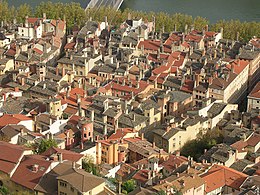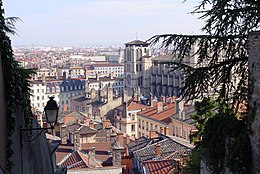Vieux Lyon
This article needs additional citations for verification. (January 2021) |
| UNESCO World Heritage Site | |
|---|---|
 | |
| Location | Lyon, Arrondissement of Lyon, Lyon Metropolis, Auvergne-Rhône-Alpes, France |
| Criteria | Cultural: (ii), (iv) |
| Reference | 872 |
| Inscription | 1998 (22nd Session) |
| Area | 427 ha (1,060 acres) |
| Buffer zone | 323 ha (800 acres) |
| Coordinates | 45°46′2″N 4°50′0″E / 45.76722°N 4.83333°ECoordinates: 45°46′2″N 4°50′0″E / 45.76722°N 4.83333°E |
 Location of Vieux Lyon in Auvergne-Rhône-Alpes | |


The Vieux Lyon (English: Old Lyon) is the largest Renaissance district of Lyon. In 1954, Vieux-Lyon, the city's oldest district, became the first site in France to be protected under the Malraux law to protect France's cultural sites. Covering an area of 424 hectares between the Fourvière hill and the river Saône,[1] it is one of Europe’s most extensive Renaissance neighborhoods.[2] There are three distinct sections: Saint Jean, Saint Paul and Saint Georges. In 1998, Vieux Lyon was inscribed on the UNESCO World Heritage List along with other districts in Lyon because of its historical importance and architecture.[2]
The Saint Jean quarter: in the Middle Ages, this was the focus of political and religious power. The Cathedral of St Jean, seat of the Primate of Gaul, a title still conferred upon the archbishop of Lyon, is a good example of Gothic architecture. The Manecanterie adjoining the cathedral is one of Lyon's few extant Romanesque buildings. Formerly a choir school, it now houses the museum of the cathedral’s treasures. Saint Jean is also home to the Museum of Miniatures and Film Sets, located in a building that was the Golden Cross Inn in the 15th century.
The Saint-Paul section: in the 15th and 16th centuries predominately Italian banker-merchants moved into sumptuous urban residences here called hôtels particuliers. The Hôtel Bullioud and the Hôtel de Gadagne are two magnificent examples and the latter now houses the Lyon Historical Museum and the International Puppet Museum. The Loge du Change stands as testimony to the period when trade fairs made the city wealthy. The Saint Paul church with its Romanesque lantern tower and its spectacular spire mark the section’s northern extremity.
The Saint Georges section: silk weavers settled here beginning in the 16th century before moving to the Croix Rousse hill in the 19th century. In 1844, the architect Pierre Bossan rebuilt the St George's Church on the banks of the Saône in a neo-Gothic style. In the Middle Ages, when there were only a few parallel streets between the hill and the Saône, the first traboules were built. Derived from the Latin trans-ambulare, meaning to pass through, traboules are corridors through buildings and their courtyards, connecting one street directly with another. Visitors can discover an architectural heritage of galleries and spiral staircases in these secret passageways, as unexpected as they are unique.
Gallery[]

Well in Cour Philibert Delorme, rue Juiverie

Hôtel de Bullioud, rue Juiverie

Buildings in the rue du Bœuf

Rue Juiverie

Statue at the corner of rue du Bœuf and Place neuve Saint Jean

Lyon Cathedral and the Saône, in background the Fourvière hill

Building in Saint-Paul
Gare Saint-Paul

Cathedral and the (one of the oldest buildings in Lyon)

Rue Saint-Jean, the main street of Vieux Lyon

Chamarier house

A courtyard and its staircase tower

A staircase

Windows in medieval style

Windows in medieval style

Hôtel de Gadagne

The 'tour rose' (pink tower)

The main gate of the 'Tour rose' in Renaissance style
Saint-Paul[]
Saint-Paul is the quarter surrounding Gare Saint-Paul, built in 1873, and the homonymous church. It is the scholastic pole of Vieux Lyon, with two main institutes, les Maristes et les Lazaristes. The church of Saint Paul itself was built for the first time in 549 and rebuilt in the 11th and 12th centuries.
See also[]
References[]
- ^ ONLYLYON Tourisme, Lyon Metropole and the region, districts of Lyon, Vieux Lyon
- ^ a b "Historic Site of Lyon". UNESCO World Heritage Centre. United Nations Educational, Scientific, and Cultural Organization. Retrieved 24 October 2021.
- 5th arrondissement of Lyon
- Quarters of Lyon
- Tourist attractions in Lyon



















